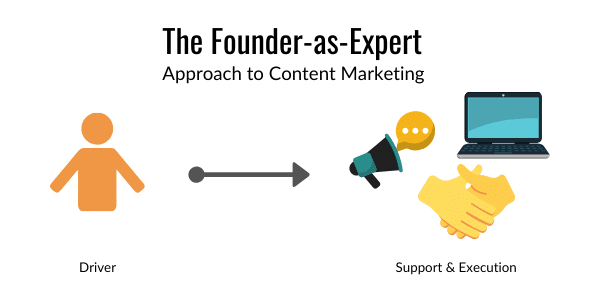The early days of a startup are the craziest and most hectic.
When you work for a large company, it’s okay if things sometimes fall through the cracks. It’s not a problem if you have periods of limited focus and productivity. There are enough people to provide redundancies and pick up the pieces.
But in a startup, that’s not the case. Every minute matters. Every second matters.
It’s like Anne Hathaway’s character said in the film Interstellar. Time is a commodity. And you’re responsible for investing that commodity into your business in the best way possible.
Everything you do must drive the revenue growth you need to get to the next fiscal year or the next round of funding. The copy for your website, the contents of your blog, the posts you put on social media, all of them can contribute to both short- and long-term revenue goals:
- Building brand awareness around both your company and your products by keeping your company top of mind
- Generating new leads by attracting your potential customers and offering them the opportunity to convert
- Educating both prospects and customers on product offerings through demonstration of use cases and other promotional materials
- Nurturing current customers to keep them engaged and, hopefully, convince them to spend more money in the future.
The benefits of content marketing are clear. But that doesn’t remove the barrier of execution, especially if your team consists only of the founder, a product manager, a salesperson, and a marketer (which is a common makeup in the early days) — and outsourcing through a content agency isn’t an option at this point.
With that small of a team, coming up with content ideas and executing against them can be intimidating. But like everything else in startup life, if everyone comes together hustles, you can generate results fast.
As 60% of businesses – not just startups – have trouble consistently producing content, if you can figure this out, then you’ll set yourself ahead of your competitors. Here are three approaches to content marketing for small teams.
Identifying the Jobs to Be Done
But before we get into the specific ways you can organize your team to create and promote content, it’s important to lay out everything that needs to be done.
In reality, content marketing isn’t one job per se, but a multi-step process that you can divide among your team members:
- Ideation. Carefully select topics so you’re focusing exclusively on the questions your audience is asking and the things they’re interested in.
- Research. Substantiate your claims, find out what other thought leaders are saying, and see whether there’s a unique perspective you could take that makes you stand out.
- Outlining. Organize your collective thoughts and gather feedback before getting full sentences and paragraphs onto the page.
- Writing (or recording). Actually create the content.
- Editing. Don’t just edit for grammar and punctuation, but clarity, logic, and relevance to your audience.
- Promoting. Spend more time distributing the content over social media and other channels than you do creating it.
- Analysis. Look at the quantitative metrics like engagement rates, bounce rates, & time on page, as well as the qualitative information like what people are saying in the comments.
- Repurposing. Make every piece of content go farther by repurposing them for use in other channels.
Once you’ve identified what needs to be done, the next step is to figure out the best people to do it. I’m going to present three scenarios for how to take the jobs listed above and distribute them among your team.
The point here isn’t to provide a one-size-fits-all solution. Instead, use these as jumping-off points to get you thinking about how you can maximize everyone’s strengths and start creating content – and realizing the benefits – now.
1. The Founder-as-Expert
By virtue of their role, your founder is an expert in their industry and niche.
Because they saw a gap in the market and created a solution, they know the landscape and how to address the problems your market is facing.
Because they’ve raised funds or closed new deals as a new business, they know how to strategically position themselves as a value-add.
Because they’ve been involved in every aspect of the business so far, they know what you need in order to succeed and can help steer conversations that meet those needs.
That’s why in the early days of a startup, leveraging the “Founder-as-Expert” approach could be a good solution to maximizing how much relevant content you can produce by having the expert in the room drive the process.
One way you could breakdown the tasks is the following:
- Founder: Comes up with ideas and writes the initial draft
- Product: Provides feedback based on their knowledge of the product
- Sales: Edits based on their conversations with customers and then promotes the content once it’s been published
- Marketer: Offers their own changes/insights, publishes and promotes the content, and conducts the back-end analysis to measure results
For all the benefits of this model, there is a word of caution. There’s a danger that the founder could become a bottleneck in the process.
So in order for it to work, the founder must have 100% buy-in into the importance of investing their time in content. More than that, they should actively guard time to work on the content.
If you can effectively leverage the expertise of your founder, it could pay off in dividends when it comes to brand equity and, later, revenue.
2. The Marketer’s Push
The Founder-as-Expert approach works when you have a founder with more experience than the marketer. But when the roles are reversed, the Marketer’s Push may be a better option.
It’s probably the most commonly used model in most companies, startups and larger businesses alike.
The Marketer’s Push doesn’t negate the important role that the founder plays in the substance and quality of the content being created. In fact, all three of these approaches should leverage that unique expertise.
However, this approach does place the marketing leader as the primary driver of the whole process. They take a much more active role in the creation of the content, as well as promotion.
They take the lead in ideating, leaning on the team for insights but taking responsibility for delivering those content ideas. They then write the content, maybe bringing in the founder or salesperson to help, and then get everyone’s feedback.
Finally, they promote, analyze, and repurpose the content to further their marketing goals.
Sounds like a lot of work, right? And therein lies a potential problem.
The danger with this model is the fact that the labor rests entirely on the marketer. Although that may not seem like a problem – after all, content marketing is part of their area of responsibility – not having a team to support them could lead to burnout.
It’s important under this approach to have reasonable expectations and, when necessary, outsource or hire some help.
3. The Sales Stimulus
This final approach is one that not many people talk about, primarily because the conversation around content has for the last decade centered almost entirely around top-of-funnel content.
But your content is not only an attraction, brand, & lead gen tool. It’s also a product marketing and customer nurture tool.
A great advantage of creating content is that you can leverage it to make the sales process as frictionless as possible, creating a more meaningful experience for your buyer.
Plus, bottom-of-funnel content attracts bottom-of-funnel visitors, which will likely convert easier and close faster, making your sales cycle and path to revenue that much shorter.
With that in mind, a third approach to content marketing is to make it a sales-centric process. This is especially helpful if your marketer is measured more on the revenue or qualified leads they bring in. They can leverage the unique skill set of the salesperson to create content that converts and brings in new business.
In this model, the salesperson comes up with the topic and takes the lead in creating it, relying on the team, including the marketer, to edit, provide feedback, and promote it.
It may be prudent to have your marketer involved in the editing process to make the content more helpful and less promotional. While you shouldn’t be afraid to reference what your products, there’s a balance with bottom-of-funnel content that a salesperson probably won’t have.
Remember: this is content writing, not copywriting. It’s not an ad, it’s an article.
Now, if you’re having trouble convincing your salesperson to get on board with this model, tell them that content marketing will save them time and get them more leads.
By answering common questions and publishing them on the website, they can save time by not having to repeat the same thing in email after email. This frees up time to prospect, nurture leads, and close more deals.
All three approaches leverage the resources you already have at your disposal and, if done well, help augment everyone’s effectiveness in their other responsibilities rather than detract.
If you can the buy-in from your team and choose the structure that works for your goals, you’ll find that you can create a lot more content than you think, and set yourself up for success in the future.









